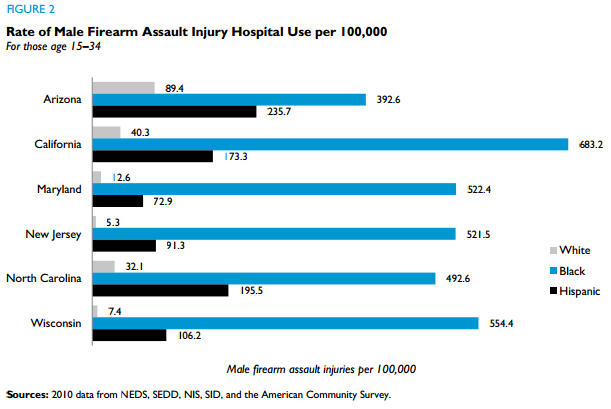| Online: | |
| Visits: | |
| Stories: |

| Story Views | |
| Now: | |
| Last Hour: | |
| Last 24 Hours: | |
| Total: | |
The Ratio of Non-Fatal to Fatal intentional Shootings
How many people who are deliberately shot survive, compared to those who are shot and killed? Some early work on this subject was done decades ago. In 1968, Franklin Zimring published a study done in Chicago that showed a 7.5% lethality rate for firearms wounds. It is mentioned in Restricting Handguns, the Liberal Skeptics Speak Out, on page 111. That would be a ratio of about 12 to one. In 1985, Cook found that about 15% of assault linked gunshot victims that were known to police, died. That would be a ratio of 5.67 to one.
A recent study by the Urban Institute(pdf) helps to shed some light on this ratio. It gives fairly precise figures for firearm assault injuries that are reported by hospitals, for Black males 15-34.
By finding the ACS numbers for the population of 15-34 year old Black males in Wisconsin, we can determine the number of assaultive gunshot victims that were reported by hospitals. The population number, according to ACS estimates, is 16.5% of the Wisconsin black population, or 59,259. This matches well with the 2010 census figures of 59,522. The number of assaultive gunshot victims then comes to .59259 x 554.4 or 307. The article points out that 6.5% of these hospitalizations ended with the victim dying, so the non-fatal hospital reports are .935 x 307 or 287.
With a little digging, I found the National Violent Death Reporting System has Wisconsin firearms homicides listed for 2010. It only has this data for 18 states, and Wisconsin is one of them. It lists 37 Black male homicides victims from intentional gunfire in 2010 aged 15-34. The non-Hispanic White and Hispanic male fatality numbers for the age group were both less than 10, so they were not available. Together, they were only 13.
We now have a workable ratio for non fatal to fatal shootings recorded by hospitals, or lethality of assaultive shootings. It is 287 to 37, or 7.76 to one. That is in between what Cook reported in 1985 and what Zimring reported in 1968. However, this is a limited slice of the population. It is not hard to believe that older groups would have different results.
Young Black males are the group most involved in crimes, but young people are more likely to survive trauma.
I was a little surprised at the numbers. As most shootings involve handguns, I expected a higher number of survivors. Talking to knowledgeable friends, most thought the ration would be closer to 10-1. Perhaps that comes from the earlier work by Zimring. One thought he had read of military studies with the 1-10 ratio.
There are uncertainties. These results are only from Wisconsin, but the Wisconsin fatality percentage (6.5% once the hospital is reached) is listed as the same as the national percentage.
Some people may choose not to be treated for minor gunshot wounds. I suspect the number is small. Similarly, some murder victims may not be found. Again, I suspect the number is small.
While not definitive, I find this ratio to be interesting. I will be looking at national numbers in the future.
©2014 by Dean Weingarten: Permission to share is granted when this notice is included.
Link to Gun Watch
Source: http://gunwatch.blogspot.com/2014/09/the-ratio-of-non-fatal-to-fatal.html




